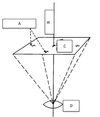chapter 4 Flashcards
(114 cards)
aerial photograph
any photograph taken from the air
An aerial photograph, in broad terms, is any photograph taken from the air. Normally, air photos are taken …………………… using a ……………………………………..
vertically from an aircraft
highly-accurate camera.
There are several things you can look for to determine what makes one photograph different from another of the same area including
type of film, scale, and overlap
Other important concepts used in aerial photography are
stereoscopic coverage, fiducial marks, focal length, roll and frame numbers, and flight lines and index maps.
Optics refer to
lenses and the geometry of light retrieval in a camera
Optics refer to lenses and the geometry of light retrieval in a camera. The lenses in a camera are responsible for
focusing and zooming on an object
Before light reflected from an object ………………………, it must pass through
strikes the film
one or more lenses
As light passes through a lens, it is
bent to focus the imaged object on the film
To minimize distortions associated with the use of ………………
single lenses
To minimize distortions associated with the use of single lenses, most camera lenses are actually composed of …………………………. that work in concert to
multiple lenses
form an image onto the film
most air photo missions are …………. using ………………
flown
black and white film
most air photo missions are flown using black and white film, however ……………………………………………..are sometimes used for special projects
colour, infrared, and false-colour infrared film
Film in a camera is used to record the image that passes through the
lens
Photographic film is composed of
a durable base
Film in a camera is used to record the image that passes through the lens. Photographic film is composed of a durable base, which is coated with a ………………………….. known as the …………………..
light-sensitive layer know as the emulsion
During the short time that a shutter is open
light strikes the film and leaves a latent image on the emulsion
. During the short time that a shutter is open, light strikes the film and leaves a latent image on the emulsion. This image can be made visible by
the process of developing and printing.
Emulsions are made of
materials sensitive to particular regions of the electromagnetic spectrum
Emulsions are made of materials sensitive to particular regions of the electromagnetic spectrum. For example,
some film is only sensitive to visible light, whereas other film is sensitive to near-infrared light
In color film, the emulsion is composed of
three layers, with each being sensitive to different wavelengths of light,
In color film, the emulsion is composed of three layers, with each being sensitive to different wavelengths of light, normally
blue, green and red light.
With black and white film, the emulsion is sensitive to
to a broad spectrum of light
Film emulsions are generally limited to recording wavelengths between
0.4 to 0.9 micrometers
Black and white film sensitive to
visible light




















